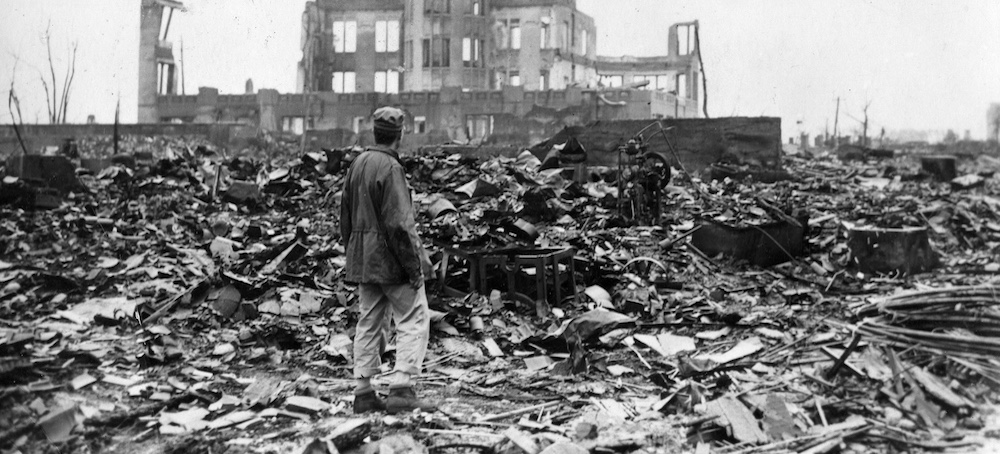It’s Time to End the Myth That the US Needed to Drop Atomic Bombs to End World War II
Michael Childers The Charlotte Observer On Sept. 8, 1945, about a month after the first atomic bomb ever used in warfare was dropped by the United States, an Allied correspondent stood in the rubble in front of the shell of a building that was once an exhibition center and government office in Hiroshima, Japan. (photo: Popperfoto/Getty Images)
On Sept. 8, 1945, about a month after the first atomic bomb ever used in warfare was dropped by the United States, an Allied correspondent stood in the rubble in front of the shell of a building that was once an exhibition center and government office in Hiroshima, Japan. (photo: Popperfoto/Getty Images)
It was disappointing to see debunked myths about World War II published recently in The Kansas City Star as if they were undisputed facts. Those assertions were that:
- President Harry Truman’s use of atomic bombs on Hiroshima and Nagasaki was necessary to end the war.
- The war was then only at a midpoint.
- The use of these weapons saved “half million lives.”
In truth, by June 1945, Japan had been militarily defeated, its once powerful Imperial Navy and air services capable of little resistance. Gen. Dwight D. Eisenhower said of these bombings: “The Japanese were ready to surrender, and it wasn’t necessary to hit them with that awful thing.”
Most American military leaders criticized the bombings publicly after the war, including Truman’s chief of staff, Adm. William D. Leahy and even the well-known war hawk Gen. Curtis LeMay, who led the bombings over Tokyo, and who said in a press conference on Sept. 20, 1945: “The war would have been over in two weeks without the Russians entering and without the atomic bomb.” When asked to clarify, LeMay said, “The atomic bomb had nothing to do with the end of the war at all.”
Gar Alperovitz — perhaps the historian who knows the issue best, having written the books “Atomic Diplomacy: Hiroshima and Potsdam” and ”The Decision To Use The Atomic Bomb,” with seven collaborators and 112 pages of endnotes — says that the 1990 declaration by J. Samuel Walker, chief historian of the U.S. Nuclear Regulatory Commission, convinced him that the use of atomic weapons on Japan was unnecessary. Walker said:
“The consensus among scholars is that the bomb was not needed to avoid an invasion of Japan to end the war within a relatively short time. It is clear that alternatives to the bomb existed and that Truman and his advisors knew it.”
On Aug. 5, 2005, Kai Bird and Martin J. Sherwin, co-authors of “American Prometheus: The Triumph and Tragedy of J. Robert Oppenheimer,” wrote an article in The Los Angeles Times entitled “The myths of Hiroshima.” In it, they said:
“The hard truth is that the bombings were unnecessary. A million lives were not saved. Indeed, McGeorge Bundy, the man who first popularized this figure, later confessed that he had pulled it out of thin air in order to justify the bombings in a 1947 Harper’s magazine essay he had ghostwritten for Secretary of War Henry L. Stimson.” (Since the total American casualties in WWII were 405,000, the suggestion of an invasion of Japan taking one million or half a million American lives is ludicrous, and Bundy vacillated between one million and half million.)
“By the time historians were given access to the secret files necessary to examine this subject with care, the myth of huge numbers of American, British and Japanese lives saved had already achieved the status of accepted history,” Rufus E. Miles Jr. wrote in the journal International Security in fall of 1985. Had they focused on the “striking inconsistencies between” the wartime documents and “those parts of the principal decision-makers’ memoirs that dealt with estimates of lives saved. Had they done so, and followed the subject where it led, they would have been forced to conclude that the number of American deaths prevented by the two bombs would almost certainly not have exceeded 20,000 and would probably have been much lower, perhaps even zero,” Miles concluded.
The real truth was suppressed for some time, but now that the records are available, it is time for the real story to come out.



